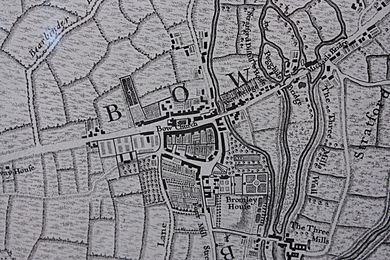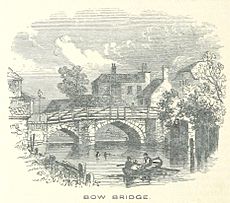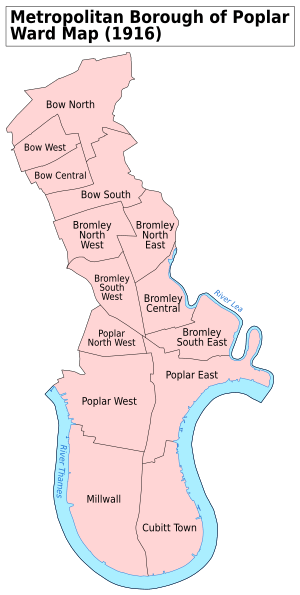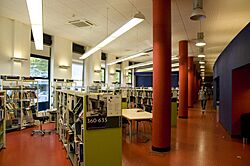Bow, London facts for kids
Quick facts for kids Bow |
|
|---|---|
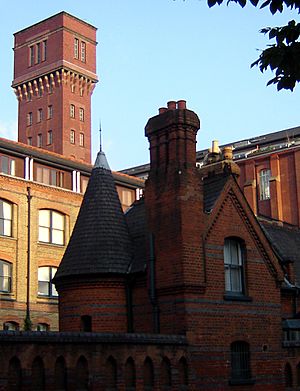 Former Bryant and May match factory |
|
| Population | 27,720 (2011 census Bow East and Bow West wards) |
| OS grid reference | TQ365825 |
| • Charing Cross | 4.6 mi (7.4 km) W |
| London borough | |
| Ceremonial county | Greater London |
| Region | |
| Country | England |
| Sovereign state | United Kingdom |
| Post town | LONDON |
| Postcode district | E3 |
| Dialling code | 020 |
| Police | Metropolitan |
| Fire | London |
| Ambulance | London |
| EU Parliament | London |
| UK Parliament |
|
| London Assembly | |
Bow (pronounced like "bow" in "bow and arrow") is a lively area in East London, England. It's part of the London Borough of Tower Hamlets. This inner-city neighborhood is about 7.4 kilometers (4.6 miles) east of Charing Cross, a central point in London.
Long ago, Bow was part of Middlesex county. It became part of the County of London in 1888. The name "Bow" is a shorter version of its old medieval name, Stratford-at-Bow. This name comes from the special bow-shaped bridge that was built here in the early 12th century.
Bow is home to parts of two famous parks: Victoria Park and the Queen Elizabeth Olympic Park. While Old Ford and Fish Island are small areas within Bow, Bromley-by-Bow to the south is a separate place. These differences come from old parish borders.
Bow has seen many changes and improvements, especially to its homes. This was partly because the 2012 Olympic Games were held nearby in Stratford.
Contents
- History of Bow
- Geography of Bow
- Governance and Representation
- Community Life in Bow
- Churches in Bow
- Services in Bow
- Education in Bow
- Transport in Bow
- Industry in Bow
- Notable People from Bow
- See also
History of Bow
Bow has a long and interesting history, especially as a crossing point.
Bridges and the Name Bow
The area was first recorded as "Stratforde" in 1177. This name means "paved way to a ford" in Old English. The original river crossing was at Old Ford, about 600 meters north. This was part of an ancient trackway. When the Romans came, they built a paved road from London Bridge to Colchester. This road crossed the marshes with a stone pathway.
Around 1110, Matilda, who was the wife of King Henry I, reportedly fell at the ford. She then ordered a unique, bow-shaped bridge to be built over the River Lea. People said it was unlike any bridge seen before! Because of this special bridge, the area became known as "Stratford of the Bow," or simply "Bow." This helped tell it apart from Stratford Langthorne on the other side of the river.
Land and a mill were given to Barking Abbey to help maintain the bridge. The Abbey also had a small chapel on the bridge, used until the 15th century. This important route was later called "The Kings Way."
Keeping the bridge in good repair was often a problem. After the monasteries were closed, local landowners became responsible. The bridge was made wider in 1741, and people had to pay tolls to help cover the costs. Arguments about who should pay for maintenance lasted until 1834. The bridge was rebuilt again in 1834. In 1967, a new, modern bridge was built, along with a flyover for traffic. This flyover has since been expanded to four lanes.
Religious Life in Bow
Anglican Churches
St Mary Stratford Bow
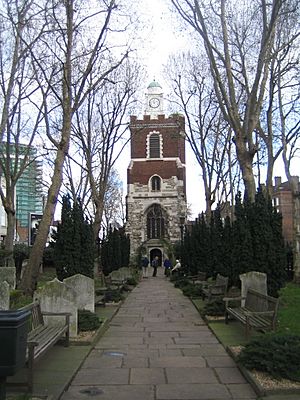
In 1311, Bow was a small, isolated village. Floods often cut it off from the main church in St Dunstan's, Stepney. So, people were allowed to build a small chapel of ease for local worship. King Edward III gave the land for the chapel, which was on the King's highway. This started a tradition of building churches on "islands" of land.
In 1556, during a time of religious change, many people were brought to Bow Church and faced harsh punishments. This happened under the authority of Bishop Edmund Bonner. In 1719, the Bow parish became independent from Stepney. The parish of St Mary Stratford Bow was then officially recognized. It included the Old Ford area, also known as North Bow.
Catholic Churches
The Guardian Angels
This church, located at 377 Mile End Road, opened in 1903. The Duke of Norfolk paid for it to honor Lady Margaret Howard, who did a lot of charity work in the East End.
The Holy Name & Our Lady of the Sacred Heart
This church at 117 Bow Common Lane opened in 1894. It is also home to the Vietnamese chaplaincy for the Archdiocese of Westminster.
Our Lady & St Catherine of Sienna
Located at 179 Bow Road, this church opened in 1870. It was once run by Dominican nuns. Today, the Archdiocese of Westminster manages the parish.
Chaucer and Stratford-atte-Bowe
A group of Benedictine nuns had a convent nearby at the Priory of St Leonards, in modern Bromley-by-Bow. The famous writer Chaucer mentioned this Priory in his book, Canterbury Tales. He joked that the Prioress spoke French with an "English French" accent, which was considered less fancy than the French spoken in Paris.
Bow Porcelain

In the 17th century, Bow became a center for preparing cattle for the City market. This meant there were many cattle bones available. Two local business owners, Thomas Frye and Edward Heylyn, found a way to mix these bones with clay. They created a special kind of fine porcelain, called Bow Porcelain. People said it was as good as the best porcelain from other countries.
The Bow China Works was very successful, employing about 300 artists and workers. However, it closed around 1770 after one of its founders died. By 1776, all its equipment was moved to a factory in Derby. In 1867, during digging work at a match factory, the remains of one of the porcelain kilns were found. This discovery showed that Bow was making porcelain with bone-ash before Josiah Spode claimed to have invented the "bone china" process.
Bryant and May Match Factory
In 1888, the famous match girls' strike happened at the Bryant and May match factory on Fairfield Road. This strike was very important. It helped start the fight for women's rights and the trade union movement. The factory was rebuilt in 1911. Its brick entrance shows a picture of Noah's Ark and the word 'Security', which was a trademark on their matchboxes. Match production stopped in 1979. The building is now private apartments known as the Bow Quarter.
Suffragettes and Women's Rights
Emmeline Pankhurst started the Women's Social and Political Union (WSPU) in 1903 with her daughters, Christabel and Sylvia. Sylvia felt that the Suffragette movement wasn't doing enough for working-class women, like the match girls. So, Sylvia started her own group, the East London Federation of Suffragettes.
She set up her office at 198 Bow Road, in a baker's shop, in October 1912. The shop was decorated with "Votes for Women" in big gold letters. The local Member of Parliament, George Lansbury, even gave up his seat to support women getting the right to vote. Sylvia helped him, and Bow Road became the campaign office. They held a big rally in nearby Victoria Park. However, Lansbury lost the election, and support for the project in the East End lessened.
Sylvia then focused her efforts from Bow. When World War I started, she opened a nursery, a clinic, and a low-cost canteen for the poor at the bakery. She also published a newspaper, the Women's Dreadnought, to share her message. After the war, in 1918, some women over 30 who owned property gained the right to vote. Full equal voting rights were finally achieved ten years later.
Pankhurst spent 12 years in Bow fighting for women's rights. She faced constant risk of arrest and spent much time in Holloway Prison, often on hunger strike. She achieved her goal and also helped reduce poverty and improve social conditions for many in the East End.
Railways in Bow
In 1843, engineer William Bridges Adams started the Fairfield Locomotive Works in Bow. He built light engines and steam railcars. This business closed around 1872, and the site later became the Bryant and May match factory.
Bow was also the main office for the North London Railway. They opened their locomotive and carriage workshops in 1853. There were two train stations, Old Ford and Bow. During World War 2, the North London Railway line through Bow was so badly damaged that it was closed.
Bow station opened in 1850 and was rebuilt in 1870 in a grand style. It even had a concert hall that was 30 meters (100 feet) long and 12 meters (40 feet) wide. This hall became "The Bow and Bromley Institute," then a technical college, and later a Salvation Army hall. From the 1930s, it was a billiard hall, and after the war, it became the "Bow Palais." Sadly, it was torn down in 1956 after a fire.
Local Government
Bow was part of the large parish of Stepney until 1719, when it became its own parish. Local leaders then took charge. As the population grew, the Poplar Board of Works was created in 1855. This was replaced by the Metropolitan Borough of Poplar in 1900. Finally, in 1965, Bow became part of the London Borough of Tower Hamlets.
Between 1986 and 1992, "Bow" was the name of one of seven neighborhoods where some power was given from the council. This led to many new street signs. Today, Bow West and Bow East are two wards created in 2002. These wards include Old Ford and the eastern part of Bethnal Green. The boundaries change to make sure each ward has a similar number of voters.
Geography of Bow
Many people say that to be a true Cockney, you must be born within hearing distance of the Bow Bells. However, these bells are actually from St Mary-le-Bow church in the City of London, about three miles west. The main feature of Bow itself is the bridge over the River Lea. Today, it's a four-lane flyover that crosses the Lea and the Blackwall Tunnel approach road.
The old High Street has few active shops and is now known as Bromley High Street. There are many large apartment buildings to the south. The "island church" (Bow Church) still acts as a turning point for buses. The Blackwall Tunnel approach roads have grown from two lanes to a six-lane urban motorway. This expansion has taken up land that used to be for businesses. What remains on the east side of the road is an area of small businesses and warehouses along the canal. There's also a large supermarket near the canal bridge to Three Mills. This area is mostly considered part of Bromley-by-Bow.
Bow is mostly in the E3 postcode district. However, a small part is in E15, and the southern half of Cadogan Terrace and all of Victoria Park are in E9. Most of the E15 section has been changed to E20 because it covers the Olympic Park. The E3 postcode also includes Bromley-by-Bow, Old Ford, Mile End, and Three Mills in Newham. The modern Tower Hamlets wards of West and East Bow are more connected to the postcode than the old settlement. They are bordered by the Mile End Road to the south, the River Lea to the east, Victoria Park to the north, and Grove Road to the west.
The Hertford Union Canal connects the River Lee Navigation and the Regent's Canal. It runs west from Old Ford Lock, along the south side of Victoria Park. It links up at a basin just west of Grove Road and the park, in the north of Mile End.
Nearby places include:
Governance and Representation
Bow is in the north-east part of the London Borough of Tower Hamlets.
A special plan called the Roman Road Bow Neighbourhood Plan is being created. This plan will help set local rules for development in much of Bow and part of Mile End. It aims to add to the Tower Hamlets Local Plan. The Roman Road Trust, a community group, started this plan. They want to create a vision for a thriving high street and community. A committee for the plan meets every three weeks.
Since 2010, Rushanara Ali from the Labour Party has been the local MP. She represents the Bethnal Green and Bow area.
Community Life in Bow
The first Idea Store, which are educational community centres started by the Tower Hamlets Council, opened in Bow in 2002.
The Roman Road Community Land Trust is a group working to protect the diverse community. They want to provide truly affordable housing. This helps residents who might be forced to leave the area because property prices are rising.
Roman Road LDN is a local online magazine that covers Bow, Old Ford, and Globe Town. It became a full-time publication in 2018. By 2019, it had 2,500 subscribers, 10,000 social media followers, and nearly 100,000 unique readers each year.
The Bow Arts Trust runs a Low Cost Accommodation program in the area. This provides affordable living and working spaces for artists. These artists are interested in doing community work.
Ability Bow is a special gym for people with disabilities or long-term health conditions. It offers one-on-one exercise sessions and has special gym equipment. Each member gets a fitness program made just for them.
Churches in Bow
Bow Church (St Mary and Holy Trinity) is the historic parish church. It is part of a group of Anglican churches in Bow. Other local churches include the Roman Catholic Church of Our Lady and St Catherine of Siena, built in 1870. There is also the Victoria Park Baptist Church, built in 1872.
Services in Bow
The Bow Delivery Office, a delivery office for mail services, is located on Tredegar Road in north Bow. Mail services are provided by Royal Mail. Bow is in the Bow district, but part of it is now also in the Olympic Park district (E20). Since 2012, all incoming mail for the E postcode area is sorted at Romford Mail Centre.
The Bow PDSA Pet Hospital is located on Malmesbury Road. It provides veterinary care for pets.
Education in Bow
Several primary schools are located in Bow: St Agnes, Chisenhale Olga, and Malmesbury. Central Foundation Girls School on Bow Road is also in the area. Cherry Trees School is a special primary school located on Campbell Road in Bow.
Transport in Bow
Rail
Bow is connected to the London Underground at Bow Road tube station. This station serves the District and Hammersmith & City lines. Bow also has a Docklands Light Railway (DLR) station, Bow Church DLR Station, on the Stratford-Canary Wharf line.
Buses
Many London Buses routes operate in the Bow area. These include routes 8, 25, 108, 205, 276, 309, 323, 425, 488, D8, N25, and N205.
Roads
The A11 (Bow Road) runs east to west through south Bow. It connects the area to Aldgate in the west and Stratford in the east. At Stratford, the A11 meets the A12. From there, eastbound traffic can continue towards Ilford, the M11 (for Stansted Airport), and other places in Essex.
Bow has a council controlled parking zone. It is covered by Zone B, which includes all mini zones (B1/2/3) within the district. On Saturdays, parking controls are also enforced in north Bow.
Cycling
Bow is part of London's wide-ranging and national cycle networks. Transport for London (TfL) and the London Borough of Tower Hamlets provide public cycling infrastructure here. Key routes include:
- National Cycle Route 1 (NCR 1) - This is a long-distance leisure cycle route. It runs between Dover, Kent, and the Shetland Islands, Scotland. It's part of the National Cycle Network. The route goes through Victoria Park and Mile End Park on paths where no cars are allowed. In North London, the route runs from Canary Wharf to Enfield Lock.
- Cycle Superhighway 2 (CS2) - This is a cycling route for commuters. It goes from Aldgate in the City to Stratford in the east. Most of the route is on a special cycle track that is signposted, continuous, and free of car traffic. The route follows Bow Road through Bow, and the track is colored blue.
- Cycleway between Hackney and the Isle of Dogs - This is a proposed commuter cycle route that was suggested in 2019.
Industry in Bow
Bow Power Station
Bow power station was a large electricity generating station. It was located on Marshgate Street in Bow. It was built by the Charing Cross and Strand Electricity Supply Corporation. This company had permission to supply electricity to the City of London starting in 1899. When it opened in 1902, it was the first three-phase power plant in the UK. The station sent electricity at 10,000 volts through underground cables to substations in the City and West End. The station was known for its 16 circular steel cooling towers, which were 11 meters (30 feet) in diameter and 26 meters (85 feet) high. Coal was brought to the power station along the River Lea and its channels.
In 1925, Bow power station became part of the London Power Company (LPC). The LPC wanted to focus electricity generation in a few large stations, including Bow. Bow power station was rebuilt and updated several times. When the electricity industry became nationalized in 1948, ownership of Bow power station was transferred to the British Electricity Authority. It then went to the Central Electricity Generating Board.
Bow power station closed in 1969 and was later torn down.
Notable People from Bow
Many interesting people have lived, worked, or studied in Bow:
Actors and Entertainers
- Donald Crisp (1882–1974) – an award-winning actor, was born in Bow.
- Graham Norton – a well-known comedian and television presenter; lives in Bow.
- Danny Wallace – a filmmaker, comedian, writer, actor, and presenter; lives in Bow.
- Roger Allam – an actor known for ITV's Endeavour, was born in Bow.
Authors
- Rosa Nouchette Carey (1840–1909) – a children's novelist; was born in Stratford-le-Bow.
- Kia Abdullah – an author; was born in Mile End and went to school in Bow.
Musicians
- Amy Winehouse (1983–2011) – a famous jazz singer-songwriter; had a flat in Bow.
- Dizzee Rascal – a grime MC, is from Bow.
- Tinchy Stryder – a grime MC, is from Bow.
- Wiley – a grime MC, pioneer, and record producer, is from Bow.
Sportspeople
- Ashley Cole – a footballer who played for Arsenal's "Invincibles" team; was born in Stepney and attended Bow Boys School in Bow.
- Ledley King – a former footballer and defender for Tottenham Hotspur; was born in Bow.
- Lotte Wubben-Moy – a footballer who plays for Arsenal Women and for the Lionesses; was born in Bow.
Others
- John Robertson (1816–1891) – served as Premier of New South Wales, Australia, five times; was born in Bow.
- Clara Grant (1867–1949) – an educational pioneer and social reformer, lived and worked in Bow.
See also
 In Spanish: Bow (Londres) para niños
In Spanish: Bow (Londres) para niños



